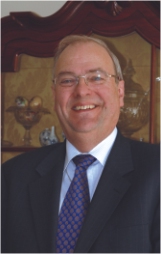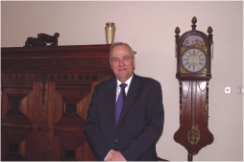 Keen to help restore the architecture, see reform in the judiciary and dazzle delegations with business opportunities, trained lawyer and career diplomat Pieter Jan Wolthers talks to Michael Bird about Dutch explorations in the Balkans
Keen to help restore the architecture, see reform in the judiciary and dazzle delegations with business opportunities, trained lawyer and career diplomat Pieter Jan Wolthers talks to Michael Bird about Dutch explorations in the Balkans
Migrants from the Netherlands are no strangers to Romanian hospitality. In classical times, Roman legionaries on the Danube were formed of Dutch cavalrymen gifted from the low land tribes to the latest Caesar and, in the 12th century, mediaeval entrepreneurs from the south of Holland and north of Belgium travelled to Transylvania to develop the land, textile industry and trade. Traces of their presence in sharing agricultural techniques persist, in words for machinery, such as 'forka', which are similar in Dutch and Romanian and also, arguably, in the manner rural settlers fold their caps to keep out the sun.
Nearly one thousand years on and Ambassador Pieter Jan Wolthers hopes the two countries can again share this agricultural know-how, as he brings over a consortium of dairy farmers. Not, one hopes, taking three weeks in a horse and cart across Europe to plough the land, but jetted over by KLM to meet local SAPARD officials to discuss larger units for dairy production and milk quotas.
After his appointment in 1999, Wolthers has been keen to promote such Dutch interests in the business, social and cultural spheres.
“Since the end of the Cold War we are getting to know each other better,” he says. “This has created an interest in business circles. If there is a Dutch national habit, it is that business people know how to venture out into new areas.”
Some Dutch entrepreneurs feel stifled by the restriction of opportunities in their own country and, like the exploratory nation it once was, feel more comfortable roaming the world for future financial enrichment.
“In the Netherlands, we live in a society that is overly organised, we cannot do a lot of things without stumbling on rules and regulations,” says Wolthers. “Here this is less the case and someone with inventiveness has the opportunity to be very creative.”
The combination has been between a well-educated populace with great language skills and keen to learn from foreigners, married with Holland's managerial style, says the ambassador: “This is indicated by the number of Dutch companies now run by Romanians.”
Looking to integrate the eastern nation into the EU, the Netherlands has been a keen partner in building up social institutions in Romania. Programmes, annually worth 12 million Euro, such as MATRA, have assisted local Government in decentralisation, supported the establishment of NGOs and promoted recycling and nature conservation, human rights, good governance and minority programmes.
But not everything has come up roses. Wolthers, a trained lawyer, shares with the EU fears about the dire state of the local judiciary: “Cases drag on and they are not predictable,” he says. A crunch moment will come when EU Commissioner responsible for Justice, Freedom and Security Franco Frattini arrives in July to see if sufficient progress has been made in Romania's most troublesome chapter, Justice and Home affairs. Another deciding moment will occur after 25 April, when each member state has to ratify Romania's fitness to join. “It's up to Romanians now to prove they are doing their job,” says Wolthers.
The Ambassador finds the new anti-graft crusade of the incoming Government: “Very encouraging, but we have to see results. However there seems to be less patience and tolerance [with corruption] than there used to be.”
Another obstacle to progress is the slowness of the bureaucracy, which often accelerates after a few heavy notes have been passed to a minor official.

“We are always telling Dutch firms not to go down the slippery slope of paying to an official to speed up the processes,” says Wolthers.
As deputy head of mission in Poland, the Ambassador watched a similar transition in the fragmentation of the centrally-planned energy and agriculture infrastructure. Poland chose a shock therapy privatisation opposed to Romania's gradual and tardy process. Now Wolthers believes such a quicker process for Romania “would have been better, however one should also remember where Romania was coming from in 1989. It would have been very difficult to do what we did in Poland because the population was exhausted.”
Dutch businesses have, on the whole, preferred to make greenfield investments, but the exception to the rule is the Galati shipyard which Dutch firm Damen bought in 1999. “When I came here Romania had a reputation for being a country where only welding was undertaken,” he says. “Now Galati builds ships for the Royal Dutch Navy.”
When Bucharest's National Museum of Art was shelled during the 1989 revolution, there was an outcry by the director of Amsterdam's Rijksmusuem as priceless examples of work by van Eyck, Rembrandt and El Greco were caught in the crossfire. So the museum sent Dutch Specialists to the national gallery to fix up all the bullet holes and restore the paintings, some of which are now exhibited in the European wing of the art museum on Calea Victoriei.
This kicked off further relations in artistic heritage between the two nations, which Wolthers saves great enthusiasm for. In his residence, the Ambassador says he is honoured to stay in a house designed by interwar architect Gheorghe Simotta. This open-plan living space uses abstract motifs of tessellating diamonds, large rectangular windows placed near the top of high-ceilinged rooms and narrow, parallel decorative beams throughout the house to create an atmosphere of geometry at play among a flood of natural light.
“Bucharest has a collection of beautiful buildings on the one hand and disastrous ones on the other,” says Wolthers. The Embassy has promoted projects which seek to preserve the architectural heritage of the city and prevent the sacrifice of any more treasures that took place during the Communist regime. “Romania has a good [building] legislation but its implementation is difficult and some illegal constructions take place without penalty. But I am very glad that the restoration of the old centre around the Lipscani area has been given the green light.”
This initiative, part-funded from the Netherlands, includes measures to stop the buildings falling down and improve the utilities, particularly the effects of the botched Ceausescu-era canalisation of the Dambovita river, which leaks into the houses either side. Overall, Wolthers regrets that more money is not spent on restoration, but recognises the priorities of a developing market. “Between a good museum and a good health system, one has to choose the health system,” says the Ambassador.
After nearly six years in the role, Wolthers feels honoured to have taken a senior position during a time of turbulent upheaval and development.
“This is the best posting ever in my career,” he says, although quickly issuing a caveat to say how much he enjoyed his role as deputy in Poland, “but here,” he adds, “I'm the boss.”
 Keen to help restore the architecture, see reform in the judiciary and dazzle delegations with business opportunities, trained lawyer and career diplomat Pieter Jan Wolthers talks to Michael Bird about Dutch explorations in the Balkans
Keen to help restore the architecture, see reform in the judiciary and dazzle delegations with business opportunities, trained lawyer and career diplomat Pieter Jan Wolthers talks to Michael Bird about Dutch explorations in the Balkans  “We are always telling Dutch firms not to go down the slippery slope of paying to an official to speed up the processes,” says Wolthers.
“We are always telling Dutch firms not to go down the slippery slope of paying to an official to speed up the processes,” says Wolthers.